First Ship From Kuwait Ferries Out 700 Indians : Refugees: The voyage to Emirates was difficult. Another ferry docks there with food headed to Kuwait.
www.latimes.com
More than 700 Indians arrived here Friday on board the first ship to leave Kuwait since the Iraqi invasion.
The exhausted refugees made the three-day voyage with little to eat except bread and tuna fish.
“We had hot, oily water to drink,” said a young man named Rajiv, an engineering student from New York who was visiting Kuwait when the Iraqis struck on Aug. 2. “But we are safe now.”
Sweat streamed down his face, and his eyes were bloodshot from the sun and lack of sleep.
The refugees arrived at Port Rashid on the freighter Safeer, which had docked in Kuwait before the invasion. Its Indian owner, Ibrahim Modak, told reporters:
“Instead of leaving empty-handed from a place which was brimming over with foreigners, we decided the risk was well worth it.”
Iraqi military authorities reportedly raised no objections to the Safeer’s departure.
There were more than 170,000 Indians in Kuwait, the largest non-Arab expatriate community there. Modak said he gave preference to students and visitors, “and those who could leave on very short notice.” From here, the refugees will be flown home on Air India charter flights.
Many Indians in Kuwait had crowded into the Indian Embassy compound, and those who arrived here said conditions were worsening.
“Drivers, laborers, construction workers and domestic helpers who had nowhere to go were pouring in with the hope of shelter,” said Jagat Reddy, a shipping company employee. “The whole place is filthy and slushy. It stinks, and there is little more than dry bread to eat.”
Another refugee said water supplies were drying up in the suburbs.
“Tankers used to come to supply us with water daily at the rate of 10 Kuwaiti dinars a month,” he noted. “Now we are paying five a week, and the tankers have started coming once every three days.”
An Indian banker among the refugees said Asian communities in Kuwait had about a two weeks’ supply of food. Noting the importance to the Indian economy of the workers abroad, he added:
“If rescue operations by the Indian government are not arranged swiftly, a very important source of its foreign-exchange reserves will be starved to death.”
The ship reached Dubai’s waters Thursday night but was held offshore until Friday.
Meanwhile, the Tipu Sultan, a Bombay oceangoing ferry, arrived in Dubai carrying 10,000 tons of food that the New Delhi government had planned to deliver to Kuwait in return for more Indian refugees. The government said U.N. officials had prohibited the ferry from delivering its cargo because of the economic sanctions against Iraq.
In New Delhi, the Indian government acknowledged that Iraq has refused to allow thousands of Indians to leave Iraq and Kuwait unless the ships and planes sent to take them home arrive with cargoes of food.
For days the government had denied reports that restrictions had been placed on the evacuation of Indian nationals, but External Affairs Minister Inder Gujral, speaking to Parliament, confirmed them Friday.
LA Times..https://www.latimes.com/archives/la-xpm-1990-09-08-mn-541-story.html
The exhausted refugees made the three-day voyage with little to eat except bread and tuna fish.
“We had hot, oily water to drink,” said a young man named Rajiv, an engineering student from New York who was visiting Kuwait when the Iraqis struck on Aug. 2. “But we are safe now.”
Sweat streamed down his face, and his eyes were bloodshot from the sun and lack of sleep.
The refugees arrived at Port Rashid on the freighter Safeer, which had docked in Kuwait before the invasion. Its Indian owner, Ibrahim Modak, told reporters:
“Instead of leaving empty-handed from a place which was brimming over with foreigners, we decided the risk was well worth it.”
Iraqi military authorities reportedly raised no objections to the Safeer’s departure.
There were more than 170,000 Indians in Kuwait, the largest non-Arab expatriate community there. Modak said he gave preference to students and visitors, “and those who could leave on very short notice.” From here, the refugees will be flown home on Air India charter flights.
Many Indians in Kuwait had crowded into the Indian Embassy compound, and those who arrived here said conditions were worsening.
“Drivers, laborers, construction workers and domestic helpers who had nowhere to go were pouring in with the hope of shelter,” said Jagat Reddy, a shipping company employee. “The whole place is filthy and slushy. It stinks, and there is little more than dry bread to eat.”
Another refugee said water supplies were drying up in the suburbs.
“Tankers used to come to supply us with water daily at the rate of 10 Kuwaiti dinars a month,” he noted. “Now we are paying five a week, and the tankers have started coming once every three days.”
An Indian banker among the refugees said Asian communities in Kuwait had about a two weeks’ supply of food. Noting the importance to the Indian economy of the workers abroad, he added:
“If rescue operations by the Indian government are not arranged swiftly, a very important source of its foreign-exchange reserves will be starved to death.”
The ship reached Dubai’s waters Thursday night but was held offshore until Friday.
Meanwhile, the Tipu Sultan, a Bombay oceangoing ferry, arrived in Dubai carrying 10,000 tons of food that the New Delhi government had planned to deliver to Kuwait in return for more Indian refugees. The government said U.N. officials had prohibited the ferry from delivering its cargo because of the economic sanctions against Iraq.
In New Delhi, the Indian government acknowledged that Iraq has refused to allow thousands of Indians to leave Iraq and Kuwait unless the ships and planes sent to take them home arrive with cargoes of food.
For days the government had denied reports that restrictions had been placed on the evacuation of Indian nationals, but External Affairs Minister Inder Gujral, speaking to Parliament, confirmed them Friday.
LA Times..https://www.latimes.com/archives/la-xpm-1990-09-08-mn-541-story.html
*Escape to freedom: The unsung heroes of MV Safeer
MIDDAY ARTICLE/INTERVIEW
*KUWAIT RESCUE MISSION Thirty-seven days to freedom by Capt V.R. Kekobad
Frontline Magazine Oct 12, 2018
*Ship owners dispel rumours and tell the real tale behind heroic evacuation of 722 Indians
*KUWAIT RESCUE MISSION Thirty-seven days to freedom by Capt V.R. Kekobad
Frontline Magazine Oct 12, 2018
*Ship owners dispel rumours and tell the real tale behind heroic evacuation of 722 Indians
*Sea and Job Magazine Sept. 2018
INTERVIEW WITH THE SHIPPING TRIBUNE
PART 1
PART 2
-----------------------------------
Feb 2019-COMMAND MAGAZINE
https://issuu.com/marexmediapvtltd/docs/vol_xix_27-19_4_april_2019Article in Marex magazine 4 April 2019
-----------------
When a cargo ship evacuated 722 stranded Indians from Iraq-occupied Kuwait
Bollywood film Airlift may have immortalised this 1990 event, but a more recent documentary by Viraf Kekobad and Hanif Modak tells a very different tale
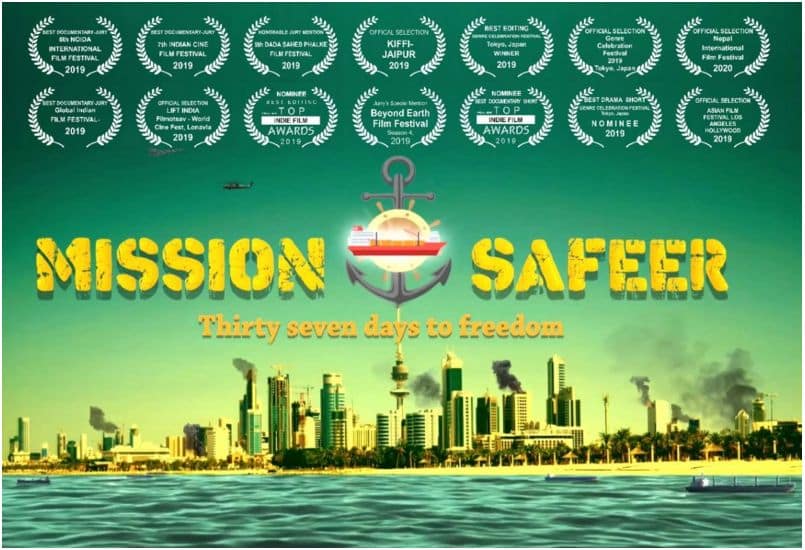
In a time when Indians around the world are desperately finding ways to get home safely, it’s worth remembering that this isn’t the first time (and probably not the last time) that we have faced tremendous odds. History is full of examples demonstrating the tenacity of the human spirit in such circumstances.
Considered the biggest sea evacuation of refugees on a cargo vessel, ‘Mission Safeer’ was the rescue mission of a cargo vessel caught in the war zone when Saddam Hussein attacked Kuwait on 2August, 1990.
The vessel was boarded by Iraqi forces and the crew of 26 Indians was interrogated at gunpoint. All provisions and goods were captured by the Iraqis and the Radio Room – the crew’s mode of contacting the ship’s owners – was sealed off. For the next month, the owners scrambled between consulates to negotiate the release of the vessel, with the help of the Indian government.
Captain Viraf Kekobad, one of the owners of the M V Safeer, now based in Gold Coast Australia, told Indian Link, “Our priority was to get the crew, many of whom I had sailed with, back to safety.”
When the Indian government announced it would evacuate Indian expatriates in Kuwait, the owners sought permissions from various authorities to use the M V Safeer for these evacuation. M V Safeer was a cargo ship designed to carry a complement of 40 crew only and arrangements had to be made to place additional life jackets and life rafts on board, as a safety measure for the evacuees to make the voyage to Dubai.
“I ran between Mumbai, Delhi and Dubai, where my senior partner, the late Captain Ibrahim Modak, was based,” said Kekobad recounted. “To get permissions to convert our cargo ship to hold passengers was a monumental task. We needed permission from our insurers, from safety authorities, from the government.”
On 11 August, over a week after the ordeal began, the Second Secretary of the Indian Embassy in Kuwait S M Mathur was allowed to board the ship to check on the crew. He confirmed that everyone was safe and in good health.
The turning point was when India’s then External Affairs Minister I K Gujral met with Iraqi President Saddam Hussein and received the green light to allow evacuations by land, air, or sea. Preparations began by the Government of India to bring its people home.
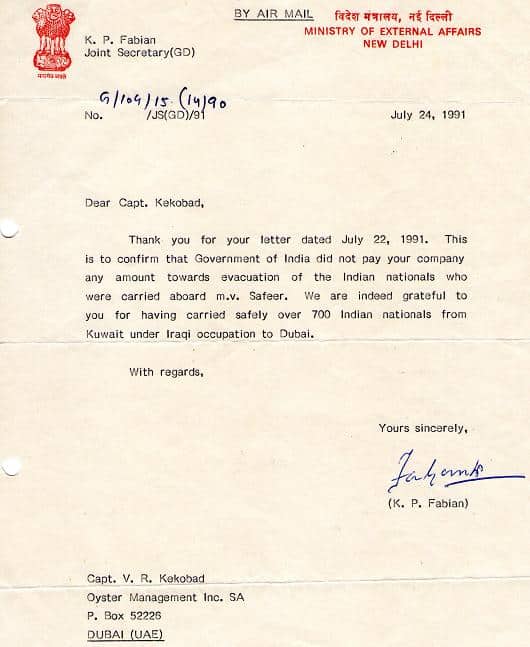
On 4 September 1990, the M V Safeer embarked with 722 Indians on board, including 265 women and children. They arrived two days later at Dubai after sailing through the mined waters of Kuwait and facing the risk of fire from Western naval forces monitoring the war zone.
“The Government of India evacuated a total of 170,000 Indians out of Kuwait during that time,” recalled Kekobad. “Our rescue mission got good media coverage in the Gulf. In the Indian media, the coverage was less so and we did not seek any publicity either. Those days, even the government did not get recognition for these efforts.”
The entire ordeal, a true story of heroism and adversity, lasted 37 days.
In 2016, Akshay Kumar-starrer Airlift immortalised these events.
“Airlift says that it was inspired by true events. Unfortunately, 95% of the movie shows falsities,” explained Kekobad. “It got this into the public domain in the wrong way.”
In the Bollywood film, the ship’s captain is depicted accepting money to take Indian refugees onboard. In reality, the M V Safeer carried out the voyage free of cost and provided food for the people on board. The movie also showed diplomats and ambassadors who worked on the evacuation, in a poor light.
“The movie really distorted history and hurt us badly,” Kekobad lamented. “Even people who know us and knew about our efforts, cast aspersions on us after the movie came out 26 years later.”
To set the record straight, the owners of the M V Safeer, Viraf Kekobad and his late partner’s son Hanif Modak, decided to create a documentary of the experience. They contacted passengers on the ship, the officers on-board and the diplomats involved in the evacuation.
“Piece by piece, we started fitting it all together. First, to contact people, you can understand the challenge we had. Over 20 years after the event, it was hard to track people down,” explained Kekobad.
The film took almost a year to complete, including obtaining footage from the BBC who had reported on the evacuation in 1990. Apart from this, the documentary also included original documents like newspaper cuttings, captain’s logs, and Kekobad’s diary at the time.
“Believe me, there were times when we thought ‘what will we do with all these old papers,’ but they came in very handy!” he laughed.

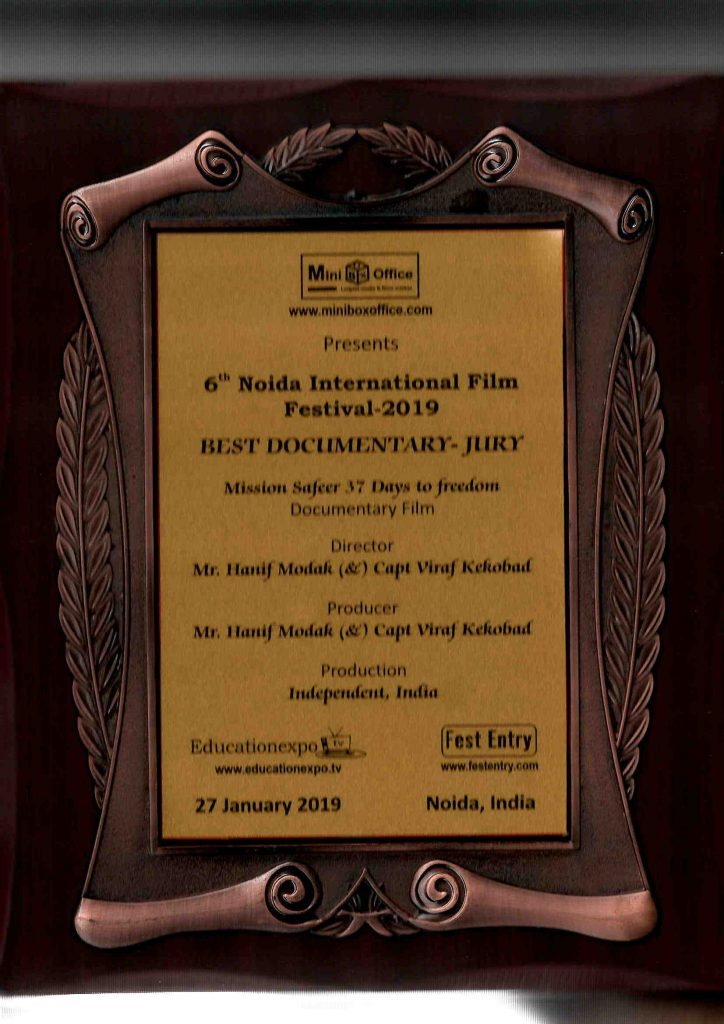
EPSON MFP image
Mission Safeer… 37 Days to Freedom has been well-received since its release in 2018, winning the award for Honourable Jury Mention at the 9th Dada Saheb Phalke Film Festival 2019 and getting selected for the Genre Celebration Film Festival 2019 in Japan.
This humanitarian mission was also recognised by the LIMCA Book of Records as the biggest rescue by the merchant navy.

Taking place three decades earlier but sounding like a familiar story of stranded Indians during the pandemic, the film serves as a reminder that we have all faced difficult odds, but with teamwork and determination, we have always made it through.
Click here to view the film
https://www.indianlink.com.au/when-a-cargo-ship-evacuated-722-stranded-indians-from-iraq-occupied-kuwait/














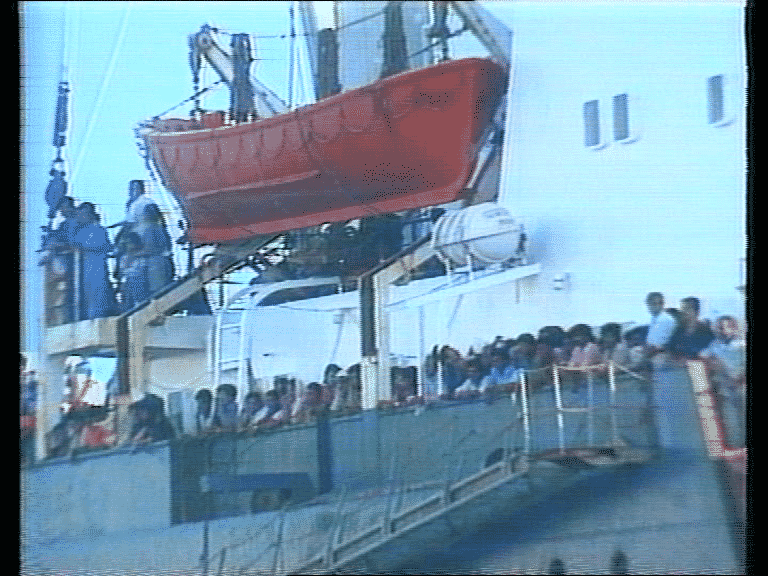
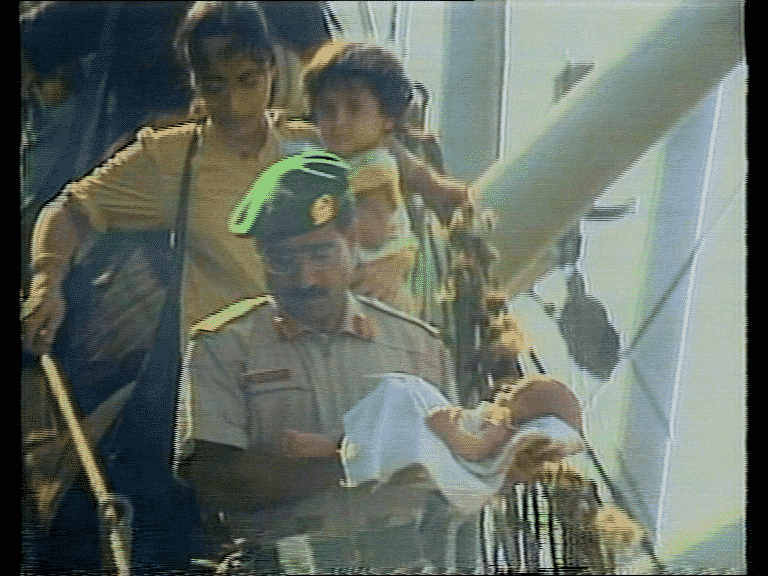
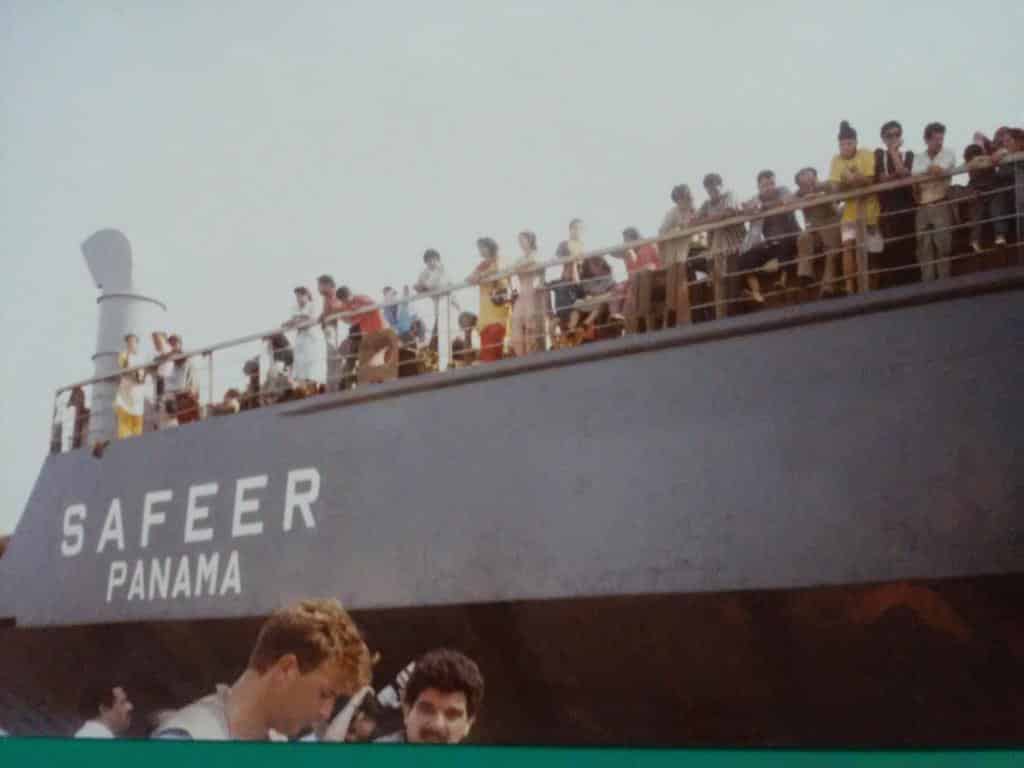
No comments:
Post a Comment